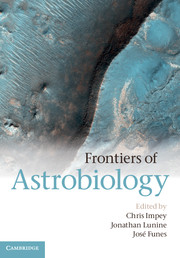Book contents
- Frontmatter
- Contents
- List of contributors
- Part I Introduction
- Part II Origin of Planets and Life
- Part III History of Life on Earth
- 5 The Early Earth
- 6 Evolution of a Habitable Planet
- 7 Our Evolving Planet
- Part IV Habitability of the Solar System
- Part V Exoplanets and Life in the Galaxy
- Index
- Plate Section
- References
6 - Evolution of a Habitable Planet
from Part III - History of Life on Earth
Published online by Cambridge University Press: 05 December 2012
- Frontmatter
- Contents
- List of contributors
- Part I Introduction
- Part II Origin of Planets and Life
- Part III History of Life on Earth
- 5 The Early Earth
- 6 Evolution of a Habitable Planet
- 7 Our Evolving Planet
- Part IV Habitability of the Solar System
- Part V Exoplanets and Life in the Galaxy
- Index
- Plate Section
- References
Summary
Introduction
We saw in the previous chapter that Earth developed a climate that supported liquid water at its surface very early in its history, probably within the first few hundred million years. That was good for life, of course, because all life that we know about on Earth requires liquid water at least episodically. There are good chemical reasons for thinking that this requirement might be universal, some of which were discussed earlier in this volume.
Here we are concerned with a somewhat later stage in Earth's history, starting from when the rock record begins, around 3.8–4 billion years ago, or 3.8–4 Gyr ago, and continuing on until the rise of atmospheric oxygen, around 2.3 Gyr ago. This time interval overlaps almost precisely with the geologic time period called the Archean Eon. Although not formally defined as such, the beginning of the Archean corresponds with the beginning of the rock record, as marked by the oldest dated fragments of continental crust at Earth's surface. We know that Earth had older rocks, based on crystals of the mineral, zircon, which survive today as sand grains in mid-Archean quartzites from Western Australia, and can be dated as far back as 4.4 Gyr ago (Valley et al. 2002). Defining the end of Archean time to be precisely 2.5 Gyr ago was a somewhat arbitrary decision of the geological community: at about this time, the dominant type of sedimentary basin switches from the granite-greenstone belt configuration (dominated by ultramafic, magnesium-rich volcanics and chemically immature sedimentary rocks) to basins controlled by thermal subsidence along passive margins. This switch in rock types may or may not have influenced the rise of O2, as discussed later in this chapter. We will henceforth use the term “Archean” to refer to the time period preceding the rise of O2, recognizing that astrobiological and geological terminologies have slightly different meanings.
- Type
- Chapter
- Information
- Frontiers of Astrobiology , pp. 115 - 131Publisher: Cambridge University PressPrint publication year: 2012
References
- 2
- Cited by



